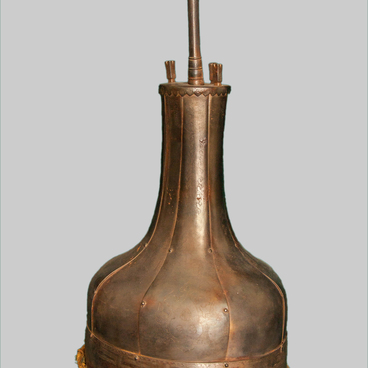According to scientific sources, silversmithing in Tobolsk developed at the end of the 17th century. The main customers of the artisans were the Tobolsk bishops, on whose behalf silver crosses and chalices were sent to Siberian churches and monasteries — the necessary attributes of worship. The craftsmen received orders from the voivodes and governors. After 1711, Swedish prisoners were sent to Tobolsk including officers who were engaged in the production of silver sets and other precious products.
Local craftsmen purchased silver from China and the Khanate of Bukhara at the Irbit fair, and 50-100 poods of precious metal were received annually from Bukharians in Tobolsk province. There are names of craftsmen made up of Latin letters in the stamps of silver products made in Tobolsk in the 1770s. These names belonged to the craftsmen of the Polish confederates who were exiled in Tobolsk. However, most of the craftsmen were still Russian.
In the 18th century, the development of silver and copper mines began in Siberia: the first silver was smelted out from the ore from the Kolyvano-Voskresensk mine. At that time, factories appeared here – first copper-smelting, and then ones focused on silver smelting. At the turn of the 18th-19th centuries, a provincial magistrate appeared in Tobolsk, which united Tobolsk silversmiths into workshops, and at that time the position of assay master was approved.
Tobolsk jewelry industry flourished in the 18th century. During the 19th century, silversmithing in Tobolsk gradually disappeared, but the products created by Tobolsk craftsmen are preserved in private collections and museums.
As for the Central Russia, the jewelry industry was born there in the 16th century. The collection of the Tobolsk Museum Reserve has the samples of tableware made in Moscow. One of these exhibits is a sugar bowl with two handles on a high tray. This item was made by craftsman Ivan Avdeev at the end of the 19th century. To decorate the item, the author used black decor, which became very popular in the 18th century. Products made in this technique are recognized as real works of art.
Local craftsmen purchased silver from China and the Khanate of Bukhara at the Irbit fair, and 50-100 poods of precious metal were received annually from Bukharians in Tobolsk province. There are names of craftsmen made up of Latin letters in the stamps of silver products made in Tobolsk in the 1770s. These names belonged to the craftsmen of the Polish confederates who were exiled in Tobolsk. However, most of the craftsmen were still Russian.
In the 18th century, the development of silver and copper mines began in Siberia: the first silver was smelted out from the ore from the Kolyvano-Voskresensk mine. At that time, factories appeared here – first copper-smelting, and then ones focused on silver smelting. At the turn of the 18th-19th centuries, a provincial magistrate appeared in Tobolsk, which united Tobolsk silversmiths into workshops, and at that time the position of assay master was approved.
Tobolsk jewelry industry flourished in the 18th century. During the 19th century, silversmithing in Tobolsk gradually disappeared, but the products created by Tobolsk craftsmen are preserved in private collections and museums.
As for the Central Russia, the jewelry industry was born there in the 16th century. The collection of the Tobolsk Museum Reserve has the samples of tableware made in Moscow. One of these exhibits is a sugar bowl with two handles on a high tray. This item was made by craftsman Ivan Avdeev at the end of the 19th century. To decorate the item, the author used black decor, which became very popular in the 18th century. Products made in this technique are recognized as real works of art.



